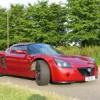
Quantum Zero Progressive Springs
#21

Posted 24 May 2013 - 02:14 PM
#22

Posted 24 May 2013 - 03:09 PM
It was a valid question given your comments about the added weight of a VXT Given the na doesn't weight that much more than a 111 I was wondering why/if it needed these compromised springs You really do like to retaliate first don't you?
why are they compromised?
(and people wonder why I am like I am?)
#23

Posted 24 May 2013 - 03:28 PM
You were like that before you came on here Simon; don't blame us.
Edited by Mike (Cliffie), 24 May 2013 - 03:28 PM.
#24

Posted 24 May 2013 - 03:41 PM
You were like that before you came on here Simon; don't blame us.
![]()
#25

Posted 25 May 2013 - 08:29 AM
If I bought my Quantum Zeros a few months a go (in fact I think I was one of the first) would I be right in saying they have linear springs fitted?
#26

Posted 25 May 2013 - 08:54 AM
#27

Posted 25 May 2013 - 08:55 AM
#28

Posted 25 May 2013 - 08:57 AM
#29

Posted 25 May 2013 - 09:12 AM
Afaik the progressive spring would have been an option when ordering. So I guess it would have been whether you selected the option or not.
Ahh I see, the web page has changed since I bought mine.
My old car had progressive springs, it was the best road handling car I ever had. It soaked up the bumps yet still cornered very well. On the track it wasn't quite so good, it wallowed in tight twisty corners. The high speed cornering was excellent but it just didn't like changing direction quickly.
My VX is predominantly a track day toy so I'm more than happy with linear.
#30

Posted 25 May 2013 - 09:57 AM
I ve not got themDon't nitrons use helper springs?
#31

Posted 25 May 2013 - 10:00 AM
I thought it was an option?I ve not got themDon't nitrons use helper springs?
#32

Posted 25 May 2013 - 10:08 AM
Yes, but helper / tender springs are not there to act as a progressive setup (other wise you'd just use a cheaper progressive spring), but to keep the primary spring in place under maximum droop. Scuffers shal l be along soon to slap us all down and tell us how it really is..I thought it was an option?I ve not got themDon't nitrons use helper springs?
Edited by Rosssco, 25 May 2013 - 10:09 AM.
#33

Posted 25 May 2013 - 10:10 AM
but helper / tender springs are not there to act as a progressive setup
Proper tender springs are meant to make for an overall progressive spring rate in combination with the main springs. Helper springs aren't.
#34

Posted 25 May 2013 - 10:13 AM
Thats probably what I was thinking of ![]()
#35

Posted 25 May 2013 - 10:41 AM
#36

Posted 25 May 2013 - 10:44 AM
#37

Posted 25 May 2013 - 11:32 AM
I thought it was just a terminology thing though, albeit that they perform different functions dependant on spring rate. I don't understand why you would use this route if you wanted a progressive setup, unless you needed adjustability in spring rates, rather than using a proper progressive spring...Proper tender springs are meant to make for an overall progressive spring rate in combination with the main springs. Helper springs aren't.but helper / tender springs are not there to act as a progressive setup
#38

Posted 25 May 2013 - 01:42 PM
With a linear helper and main spring, you can mix and match out of a modular system. Like Eibach offers. Try to specify a progressive spring. You have an uncompressed rate and a function where the increasing spring rate depends on the compression. Or perhaps to make it easier so that you don't have to calculate yourself, uncompressed rate, fully compressed rate and rate versus compression function. Even the most simple progressive spring, rate (beware, rate, not force) increasing linear with compression, requires two instead of one parameter. For example 300 to 600 lbs/inch - linear. So far more combinations, which makes it difficult for spring manufacturers.
#39

Posted 25 May 2013 - 02:05 PM
Yes, but helper / tender springs are not there to act as a progressive setup (other wise you'd just use a cheaper progressive spring), but to keep the primary spring in place under maximum droop.
Scuffers shal l be along soon to slap us all down and tell us how it really is..
well, what did you expect?
Not sure who told you that but once again..... Yes, I have to say it....... your wrong!
if your going to split hairs, a helper is not a tender, but the reality is that it;s a fine line between the two at this level.
helpers traditionally are very low rate and are just there to take up spring slack etc, this is what people (in the Lotus arena) started using them for.
I started using high rate tenders back in ~2005, the idea was because I was running pretty high main spring rates (for slicks etc), and one of the issues was the rate at which the unloaded wheel unloaded (as in as the car loaded up the inside wheel did not have go that far before it was completely un-loaded).
so I started running stiff enough tenders to just be collapsed at static ride heights, so that once the wheel starts to unload, the fall in rate was not as dramatic as without, thus maintaining better grip on the unloaded wheel.
from there, on some cars I started running even heavier tenders to the point that they were not quite 100% collapsed at static ride, thus for the first few mm of travel, overall rate was much lower (two springs end to end give a lower rate than each individually), then as the tender stops compressing, the rate will rise significantly limiting how far the car will go down under load.
this is very much what we have done with the progressives for the Quantum Zero's, we were trying to pitch the dampers are the road car market with a slightly more sporty ride, but without making them sprung so stiff that it ruined their compliance, but still could deal with the higher load stuff of a typical trackday.
the hard part with progressives is you cannot make one with infinite rate changes, and the more of a split you aim for, the harder it get's, not only achieving the slip, but also where that split is in the load/travel of the spring, it's also quite expensive to work though all this and get them made.
Yes, we could do the same for the Blacks, but the combinations would be endless and un-realistic.
#40

Posted 26 May 2013 - 10:50 AM
Isn't there a problem if you run tenders that do not fully collapse that at the moment that it does collapse (bump), spring rate suddenly increases to the rate of the main spring. For example, you use a 300 lbs/inch tender and 600 lbs.inch main spring. Combined rate is 200 lbs.inch. At the moment the tender collapses, the rate will increase to 600 lbs/inch. So you go from 200 to 600 all of a sudden. Without having any experience with it, I can imagine that it's not exactly the kind of behaviour you're looking for.
1 user(s) are reading this topic
0 members, 1 guests, 0 anonymous users























